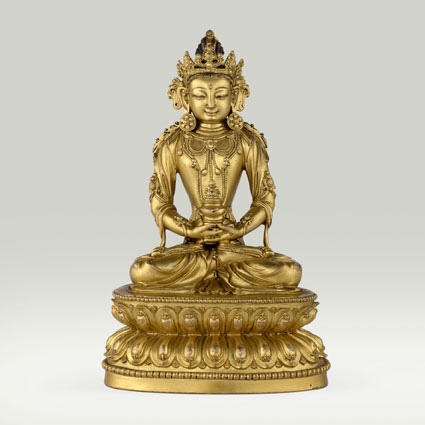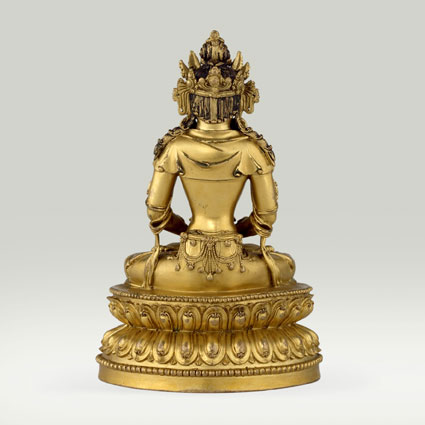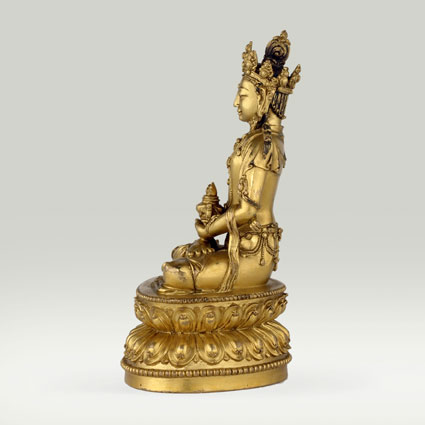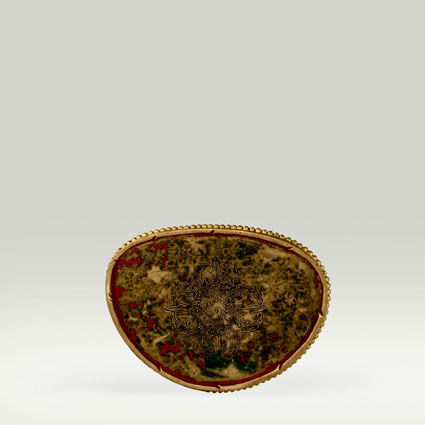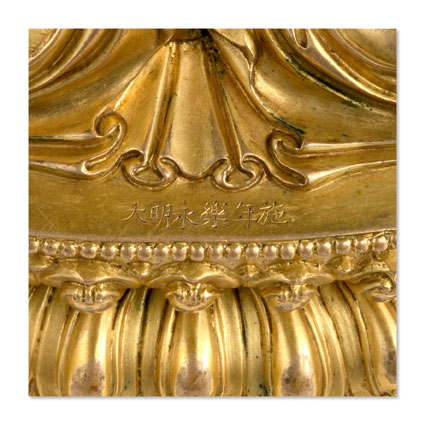ABS 114
Code: ABS 114
Country: China
Style: Ming Dynasty - Yongle Period
Date: 1403 - 1424
Dimensions in cm WxHxD: 9.7 x 15.3 x 7.2
Materials: Gilt copper
Amitayus - Buddha of “Infinite Light” holding the “Vase of Long Life” (kalasha) containing the nectar of immortality (amrita). During the Yuan (1279-1368), Ming (1368-1644), and Qing (1644-1911) dynasties a “patron and priest” relationship existed between the spiritual leaders of Tibet - acting as spiritual mentors - and the secular emperors of China - acting as patrons. Many gilt Buddhist statues were sent to Tibet by the Chinese emperors.
Amitayus is identical with Amitabha, one of the five transcendental Buddhas, also called the Victorious Ones. His colour is red, his cardinal direction is the West. His mount is the male peacock, which can devour poisonous snakes without taking any harm. His emblem is the lotus, his element is fire, and his seed syllable a red HRIH at the throat-chakra. His female equivalent (Shakti) is Pandara. His main boddhisattvas are Avalokiteshvara Padmapani, Hayagriva, Kurukulla Bhrikuti, and certain forms of Tara.
Amitabha belongs to the Lotus family. A lotus grows in muddy water while its blossoms on the surface remain flawless. Likewise, Amitabha stands for liberation from the poison of attachment (craving) and its transformation into the warming and healing fire of compassion. Freedom from this negative emotion is a state of immaculate, pure peace. Therefore, the Buddha Amitabha sits in the full diamond posture (vajraparyankasana), with both hands resting in the meditative posture of mental clarity (dhyana-mudra). With the help of this discriminating wisdom, there is no desire, no dissatisfaction and no craving for more and better things. This insight is so powerful that all things are naturally magnetized as one’s own. There is no energy and force involved as in a state of desire. It is a state of effortlessness.
Amitayus is identical with Amitabha, one of the five transcendental Buddhas, also called the Victorious Ones. His colour is red, his cardinal direction is the West. His mount is the male peacock, which can devour poisonous snakes without taking any harm. His emblem is the lotus, his element is fire, and his seed syllable a red HRIH at the throat-chakra. His female equivalent (Shakti) is Pandara. His main boddhisattvas are Avalokiteshvara Padmapani, Hayagriva, Kurukulla Bhrikuti, and certain forms of Tara.
Amitabha belongs to the Lotus family. A lotus grows in muddy water while its blossoms on the surface remain flawless. Likewise, Amitabha stands for liberation from the poison of attachment (craving) and its transformation into the warming and healing fire of compassion. Freedom from this negative emotion is a state of immaculate, pure peace. Therefore, the Buddha Amitabha sits in the full diamond posture (vajraparyankasana), with both hands resting in the meditative posture of mental clarity (dhyana-mudra). With the help of this discriminating wisdom, there is no desire, no dissatisfaction and no craving for more and better things. This insight is so powerful that all things are naturally magnetized as one’s own. There is no energy and force involved as in a state of desire. It is a state of effortlessness.

